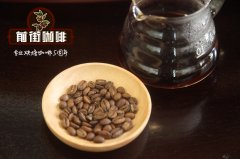How to distinguish the characteristics of Arabica coffee beans and how to distinguish roses from summer seeds

Professional coffee knowledge exchange more coffee bean information please follow the coffee workshop (Wechat official account cafe_style)
Do you know what a geisha is like? How about bourbon? There are many kinds of coffee, but people don't always know the difference between them. Apart from the differences in taste and appearance, there are obvious physiological differences between these plants.
Some coffee trees are tall and thin, while others are short and dense. Coffee fruits may vary greatly in size and color. Read on to learn more about the characteristics of the six popular Arabica coffee varieties.
How to identify different kinds of coffee
There are hundreds of kinds of coffee, but about 70% of the world's coffee is Arabica coffee. Although Arabika is more fragile than Robusta, its taste and aroma appeal to most consumers. There are many varieties of Arabica, a small number of which are grown for specialty and commodity markets.
There are many reasons why producers choose to plant varieties, including yield, shape and local environmental conditions. It is important to identify coffee varieties in order to avoid mixing in large quantities during harvest and processing. If two or more parcels are merged, it may lead to confusing profiles and lower-than-standard cup scores.
To better understand how the most common varieties are physiologically different, I studied six different Arabica. This happened between the end of the harvest season and the beginning of flowers-- about two months-- on a farm in Poquet, Panama. These farms are between 1300 and 1800 meters per mile.
The characteristics contained in this paper are obtained through the analysis of specific plants. My research is a personal observation of a limited number of farms, not as a whole.
We use certain physical characteristics (also known as phenotypes) to identify plants. These include:
Build (tall or short)
Leaf tip color (green or bronze)
Plant shape (conical or round)
The shape of a leaf (elongated or wide)
The shape and size of cherries and green beans (elongated, round or other, small, medium, large or very large)
The color of cherries (red, yellow, orange, even pink)
Branch angle
Distance between branches (short or long)
The distance between the same branch node (short or long)
It is not necessary to use all these characteristics to identify a variety, because some varieties have a distinct feature.
END
Important Notice :
前街咖啡 FrontStreet Coffee has moved to new addredd:
FrontStreet Coffee Address: 315,Donghua East Road,GuangZhou
Tel:020 38364473
- Prev

What kind of coffee is good in Nicaragua? how about American coffee? introduction to American coffee.
For more information about coffee beans, please follow the coffee workshop (Wechat official account cafe_style) Matagalpa in Nicaragua is amazing scenery, beautiful city and some of the best chocolates and coffee in the world. Would you mind a good cigar? Then this area suits you, too. The mountains of northern Nicaragua; Matagalpa may be famous in Nicaragua
- Next

Handbrew Coffee Brand recommends Esseye plus Chevy Fruit Ding Coffee Bean Flavor description
Professional coffee knowledge exchange more coffee bean information please follow the coffee workshop (Wechat official account cafe_style) in front of the street-hand coffee recommended Yega Xuefei sun fruit Ding brief introduction in the front street you can choose a lot of coffee, because we have more than 200 kinds of coffee, and irregularly update and activities, all
Related
- Beginners will see the "Coffee pull flower" guide!
- What is the difference between ice blog purified milk and ordinary milk coffee?
- Why is the Philippines the largest producer of crops in Liberia?
- For coffee extraction, should the fine powder be retained?
- How does extracted espresso fill pressed powder? How much strength does it take to press the powder?
- How to make jasmine cold extract coffee? Is the jasmine + latte good?
- Will this little toy really make the coffee taste better? How does Lily Drip affect coffee extraction?
- Will the action of slapping the filter cup also affect coffee extraction?
- What's the difference between powder-to-water ratio and powder-to-liquid ratio?
- What is the Ethiopian local species? What does it have to do with Heirloom native species?

